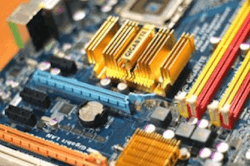What’s the Difference Between the Four Stratum Levels?
The Network Time Protocol (NTP) is a hierarchical protocol divided into “stratum levels” that define the distance from a reference clock timing source. The standard "Synchronization Interface Standards for Digital Networks," first released in 1987 by the American National Standards Institute (ANSI), lays out all of the official information and requirements for Stratum System Levels.
Instead of spending hours reading through pages and pages of the official standard, here’s a quick and easy guide to understanding stratum clock systems and the four different stratum levels.
Stratum 0
A reference clock source that relays Coordinated Universal Time (UTC) and has little or no delay is known as a Stratum 0 device. Stratum 0 servers cannot be used on the network. Instead, they are directly connected to computers that then operate as primary time servers.
Stratum 1
Stratum 1 is a completely autonomous source of timing with no other input. A reference oscillator (OCXO) is usually the main source of Stratum 1 timing. An atomic standard like Cesium Beam or Hydrogen Maser may also be the preferred choice.
It's important that the reference oscillator or atomic standard source is properly calibrated. The minimum adjustable range and maximum drift should be at a fractional frequency offset (f/f) of 1 × 10−11 or less. Doing so will prevent bit-stream timing from slipping (relative to an absolute or perfect standard) more than once every four to five months.
A Stratum 1 clock can also be considered a Primary Reference Source (PRS). PRS can be a clock system that incorporates control of GPS and/or Position, Navigation, and Timing (PNT) systems.
A Stratum 1 clock may control strata 2, 3E, 3, 4E, or 4 clocks. However, Stratum 1 clock administration, operation, and maintenance can be a costly effort.
Atomic sources may not have long maintenance-free operating intervals and could experience failures without giving an indication that the source is off frequency.
If a Stratum 1 source of timing is shown to be inaccurate, the network must be able to accept another network’s timing until the problem is corrected. The solution? GPS. It's an option to assure accuracy and minimize cost.
Stratum 2
The main purpose of the Stratum 2 system is to track an input under normal operating conditions. It maintains the last best estimate of the input reference frequency during impaired operating conditions.
Requirements of a Stratum 2 system include:
- 1.6 × 10−8 minimum adjustment/tracking range
- Less than 1.6 × 10−8 drift with no input reference in 1 year
- Less than 1 × 10−10 short term drift in 24 hours
Common examples of Stratum 2 clocks include double oven OCXOs and Rubidium standards.
A Stratum 2 clock may drive strata 2, 3E, 3, 4E, or 4 clocks.
Stratum 3
Stratum 3 is similar to the Stratum 2 clock system, but it tracks an input over a wider range. A Stratum 3 clock requires a minimum tracking range of 4.6 × 10−6. The short=term drift for Stratum 3 is less than 3.7 × 10−7 in 24 hours. That's about 255 frame slips in 24 hours during holding.
A Stratum 3 clock may drive strata 3, 4E, or 4 clocks.
Stratum 3E
Stratum 3E is an upgraded standard that takes into account SONET equipment requirements that are not available from Stratum 3 itself. Stratum 3E tracks input signals within 7.1 Hz of 1.544 MHz from a Stratum 3 or better source.
The drift with no input reference is less than 1 × 10−8 in 24 hours. This is much different than Stratum 3. Stratum 3 is about 255 frame slips in 24 hours, while Stratum 3E is only four slips.
A Stratum 3E clock may drive strata 3E, 3, 4E, or 4 clocks.
Stratum 4
The Stratum 4 clock system tracks an input adjustment and drift range of 3.2 × 10−5. In addition, Stratum 4 clock systems don't have holdover stability and run free within the adjustment range limits without a reference. The time between frame slips can be a short as only four seconds.
Stratum 4E
Stratum 4E is a proposed new clock standard that would account for a holdover characteristic that isn't free-running. This new level would be intended for customer-provided equipment by expanding their networks, but it's not yet standardized.
A Stratum 4E or 4 clock is not recommended as a source of timing for any other clock system.
What Happens During a Stratum Network Frame Slip?
What happens when a frame slip occurs during the time a clock system is in a holdover condition? Does all other network equipment stop working?
Voice-related equipment tends to re-synchronize quickly. Sometimes a pop or a click will occur, but this typically is not an issue. Data circuits may lose some bits. It all just depends on the data rate being transmitted and if forward error connection is being used or not.
Multiplex equipment that provides add and drop services might interrupt all outputs while a new source of synchronization is acquired. These interruptions can cause the entire network to be fully inoperable if due to circuit noise. A network slip in this case can be thought of like the domino effect. The slip leads to more slips down the chain of connections.
While some circuit interruptions are possible, a clock system provides a stable frequency source during times of circuit impairments. Connected equipment is not affected until the clock holdover drift results in a slip.
A high-quality stable clock will transform a network that experiences problems two to three times a day to a network that maintains timing even through major slips or outages. The network will continue to operate effectively until the outage is corrected (assuming the correction time is similar to the time of the first frame slip).
The best way to minimize the chance of frame slips occurring is to choose a high-quality clock system and correctly engineer the network. With great reliability and maintainability, near perfect timing can be achieved.


